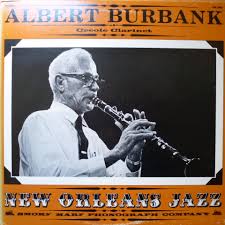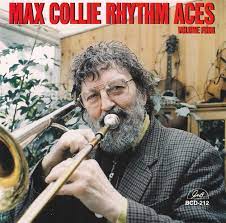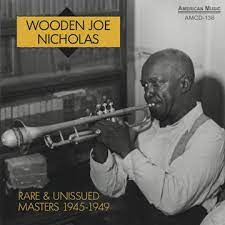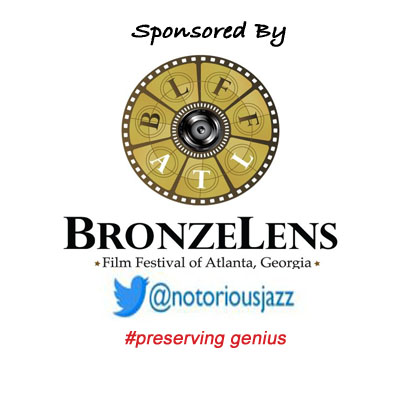
Daily Dose Of Jazz…
Albert Burbank was born March 25, 1902 in New Orleans, Louisiana and was taught clarinet by Lorenzo Tio, one of that city’s most famous clarinet players. Staying in the New Orleans area throughout the 1920s, he played wherever his services were needed. During the 1930s, he worked with Kid Milton’s band but was drafted into the US Navy during World War II.
Upon demobilization, he worked internationally with the bands of Paul Barbarin and Kid Ory. Returning to New Orleans he played with several of the well-known jazz and brass bands in the city. He was regularly seen at Preservation Hall and toured Australia with a band made up of Preservation Hall musicians.
In 1975 Albertsuffered a stroke but continued playing until his death on August 15, 1976. Many of his recordings of broadcast performances with Kid Ory’s band at San Francisco’s Hangover Club, have been issued on the Danish Storyville label, and some with trombonist Bill Matthews appear on Southland.
Burbank would go on to record with Wooden Joe Nicholas, Herb Morand, Kid Clayton, Paul Barbarin, Percy Humphrey, and Jimmy Archey.
Clarinetist Albert Burbank died on August 15, 1976 in his hometown.More Posts: clarinet,history,instrumental,jazz,music

Daily Dose Of Jazz…
John Maxwell Collie was born on February 21, 1931 in Melbourne, Australia. In 1946 he first heard professional jazz listening to Graham Bell’s lunchtime concerts at The New Theatre Melbourne. By 17 he was playing with a local band and shortly after leading it.
When he received the invitation by cable to take the trombone chair in the Melbourne New Orleans Jazz Band that was on tour in Europe, Max accepted and in 1962 arrived in England. He toured Europe until the band went back to Australia a year later, however, he decided to stay and joined the London City Stompers, becoming leader after a year. In 1966 he formed Max Collie’s Rhythm Aces and that band, notwithstanding the collapse of the UK jazz scene flourished.
The group released their first record in 1971 and in 1975 they won the World Championship of Jazz in traditional jazz against fourteen competing North American jazz bands in Indianapolis, Indiana.
He would go on to tour Sweden, Denmark, Finland, Norway and Japan and create a theater show. This show, Max Collie’s New Orleans Mardi Gras, which included Ken Colyer and Cy Laurie, turned out to be the most successful jazz show in British jazz history. Trombonist Max Collie died on January 6, 2018, at the age of 86.
More Posts: bandleader,history,instrumental,jazz,music,trombone

Daily Dose Of Jazz…
Gene Schroeder was born on February 5, 1915 in Madison, Wisconsin to a pianist mother and a father who was a trumpeter. He studied at the Wisconsin School of Music, and when he was 11 he was playing now and then with his father’s band, and doubling on clarinet in his high school orchestra a few years later.
After a year at the University of Wisconsin Music School, Schroeder moved to Milwaukee, Wisconsin. He led his own band and played with local musicians including Wild Bill Davison. His next move was to New York City in 1939 and was briefly with the Wes Westerfield Trio, then headed a combo. Gene went on to spend a year apiece as a member of the groups of Joe Marsala and Marty Marsala.
By the summer of 1942, Schroeder was working again with Wild Bill Davison then beginning in 1943 at Nick’s with Miff Mole. After becoming Eddie Condon’s regular pianist, he played at the opening of the club Condon’s in 12 1945. He was with Condon most of the time from then on up to 1962 appearing on many recordings. During his long association with Condon’s Chicago jazz bands his talent was continually overshadowed, most likely due to his being a subtle player.
He had a three year stint with the Dukes of Dixieland from 1961 to 1964 and then worked in the late ’60s with Tony Parenti. Despite his busy activity, he only led one recording session in his career, four songs cut in 1944 for the Black & White label with a trio.
Pianist Gene Schroeder died at the age of 60 on February 16, 1975 in his hometown of Madison.
More Posts: bandleader,history,instrumental,jazz,music,piano

Daily Dose Of Jazz…
Louis Keppard was born February 2, 1888 in New Orleans, Louisiana and was the older brother of cornetist Freddie Keppard. The guitarist played in the Cherry Blossom Band before leading his own group, the Magnolia Band, which included King Oliver and Honore Dutrey among its members.
He played with Papa Celestin’s Tuxedo Brass Band, Manuel Perez, and followed that residency with the Olympia Orchestra alongside Freddie. In 1917 he moved briefly to Chicago, Illinois but returned soon after. Playing in several New Orleans brass bands, Louis performed as an alto hornist and guitarist from the 1920s through the 1950s, including in the Gibson Brass Band and the Young Excelsior Brass Band.
Keppard’s style of “shuffle rhythms” was an influence on Danny Barker. He recorded with Wooden Joe Nicholas in 1949, and retired from music some time after 1962.
Guitarist, tubist and alto hornist Louis Keppard, who led a band but never recorded as a leader, died in his hometown sixteen days after his 98th birthday on February 18, 1986.
More Posts: alto horn,guitar,history,instrumental,jazz,music,tuba

Daily Dose Of Jazz…
Dick Lammi was born on January 15, 1909 in Red Lodge, Montana. Early in his career he played violin and banjo, playing as a banjoist in various dance bands and orchestras in the Pacific Northwest in the late 1920s. Settlling in Portland, Oregon in the early Thirties, and played bass in a group there.
After a move to San Francisco, California in 1936 he began playing tuba alongside bass. His best-known work was as a member of Lu Watters’s rehearsal band, which evolved into the Yerba Buena Jazz Band, playing regularly at the Dawn Club.
With World War II interrupting his tenure with the ensemble, after his discharge he rejoined the YBJB and stayed with them until they disbanded in 1950. The Fifties saw Dick working with Bob Scobey, Turk Murphy, Wally Rose, and Clancy Hayes. He recorded little after the early 1960s.
Tubist and bassist Dick Lammi, who was the first tuba player to record during the San Francisco revival, died on November 29, 1969 in San Francisco.
More Posts: banjo,bass,history,instrumental,jazz,music,tuba,violin




